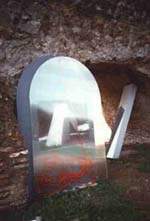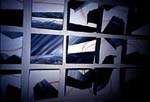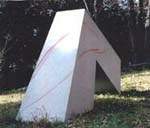ADRIANO DI
GIACOMO
Breve
Nota Biografica
Born 1948, lives in Rome.
Studies: High School of Art, Ancona; University
of Bologna (anatomical design); Academy of Fine
Arts, Roma.
Since 1969, he exhibits in personal and group
shows. Museums and Collections: Mystique Museum,
Malta; Paper's Museum, Fabriano; Bagnacavallo,
Ravenna; Museum of Modern Art, Spoleto; State
Collection Gyor, Hungary; Land Museum St.
Margherita Park, Perugia; Communication's Museum
of Senigallia City; Popular Bank of Milano;
"La Colomba", Venezia; Cafe Mozart,
Milano; Praia a Mare (Cs) Museum.
Archives: Biennale d'Arte, Venezia; Pecci Museum,
Prato; PalExpo, Roma.
Cliccate sulle
miniature per ingrandire le immagini.
   
Breve Nota
Critica
The emergence of architectural structures,
dilated by signs/symbol of the post-metropolitan
human condition and of the disgregation, featured
in the historical/political valency, through the
vision that proceeds by accumulation, enumeration
and iterance of today's archeological findings,
assaulted or absorbed, prospectively speaking,
and estranged movements, while filament drosses
pass through the empty spaces of a glance,
returning it to the painting. With
"Hyperthermia", Adriano Di Giacomo
introduces a strong element of ethical-cognitive
tension, metaphor of a collective dimension which
surpass the same metropolitan scenarios to make
itself a cosmic condition - albeit historically
featured - of a state of feverish fibrillation
which induces degenerations, in material-biolical
magma by which through oppositions, the cold
proportions of technocratical symbols of
domination are defined. The multiplicity of the
vision - brought by the continuaI and rapid
sliding of the point of view of the observer, in
a sort of dramatic perceptive ambiguity, from the
exterior to the interior of the field, from the
centre to the margins, along lines of disruptive
and striking escape, the "banality" of
perception and the "normality" of
interpretation - reconsigns the details of an
"exploded" territory on which the
artist exercises a cold analysis and pathos
gestures in order to restore post-metropolitan
images to total artificiosity. The representation
proceeds by synthetic foreshortening, given to a
strong valency feature, or by analytical
procedures, fusing the complex connection of the
elements by which a hierarchy of relations and
functions are established: starting from
"Evoluzioni e passaggi" (Evolutions and
Passages, 1995) on the ambiguous complexity of
the systems, to the most recent works (1993),
from the two large paintings dominated by an
oblique and impending "passage", to the
"box of memory" which assemble by
incongruous fragments the broken unity of an
urban cosmic from the apparent modular order, to
the rarefied and "protected" silence,
separated in the frame/box which - recovering
material and procedure of the artist already used
by the same in the early 1980's - sanctions the
approach in reducing the essential components of
being and thinking: an unfinished
"space", a territory, a sensor.
The thematic knot of the search by the artist,
right from the early 1970's, concentrates on the
analysis of spaces intended to be the places of
complex systems in which nature and history
interact, by congruity and opposition, both
organic and inorganic, with the obvious and
significant absence of man from the scene. The
complexity of the analysis conducted by the
artist - through numerous studies, researches and
activities, which leave sediments and permit the
use of various instruments and languages - is
translated in the complexity of the structures
and linguistic choices. The resultant is a
metaphor - metaphor of history - which is
foundered on the estrangement produced by the
discrepancy between the "normality" of
a hypothetical scenario as a possible, and anyhow
confirmed by its same represented state, and the
modes of its definitions and representations,
through prospectives pushed to the limit, which
run along unlimited fugues and which wager in the
apparently precarious equilibrium, in reality
burying itself under a strong constructive
projective.
A semantic purpose substantiates the work of
Adriano Di Giacomo which moves not really in
order to formulate definitions as much as
provoking questions as to why in the
destinator/observer - attracted or repulsed by
the inside/outside work, and anyhow involved -
the doubt stir up firm cognitive certainties and
pushes the eye beyond the "passage",
towards what which is placed beyond the space
temporal of the immobile fiction of the noted
order, of the reassuring "normality",
which laziness and perceptive atrophy belie.
Torna
all'indice
|




